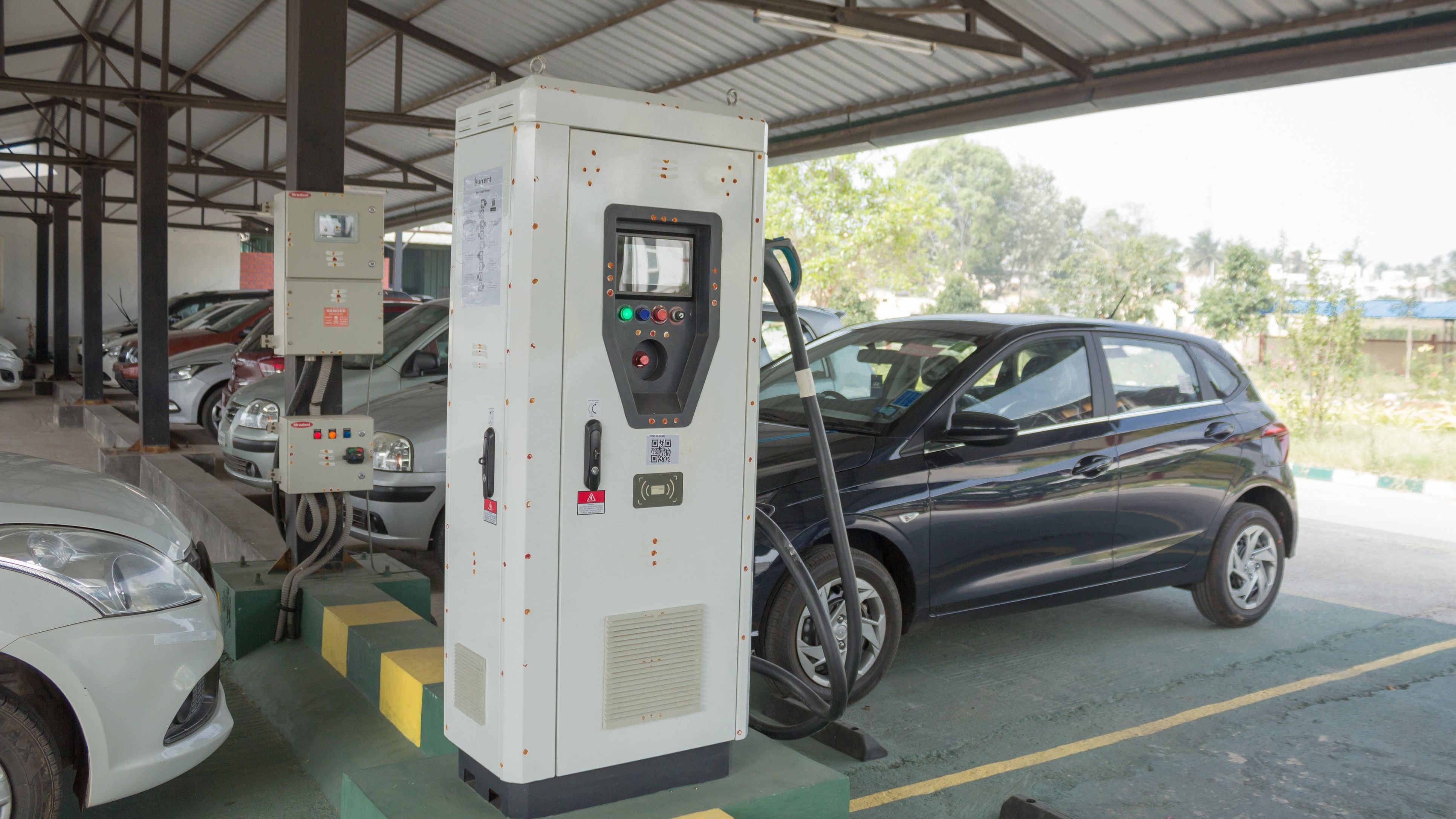
An Electric Vehicle Charging station set up recently for the public by the Karnataka government at its premises at Mysuru,India.
Credit: iStock Photo
From the late sixties to the present day, India has witnessed several revolutions, such as the green revolution, white revolution, internet revolution and the digital revolution. India appears to be on the cusp of a new revolution: the electric vehicle revolution.
The sixth assessment report of the Intergovernmental Panel on Climate Change (IPCC), released in 2022, notes that transport sector accounts for about 15% of global greenhouse gas (GHGs) emissions. One of the major goals of the Paris Climate Accord signed in December 2015, is to reduce GHGs by limiting temperature rise to 1.5 degrees Celsius or 2 degree Celsius above pre-industrial levels by 2050.
In puruit of the global goal of achieving net zero emissions by 2050 and reducing vehicular pollution, many countries, including India have been promoting the use of electric vehicles (EVs) in place of fossil fuel driven vehicles (FFVs).
The vehicle sector is undergoing a gradual transformation with policies and incentives aimed at promoting electric cars to replace fossil fuel driven cars. According to the Global EV Outlook 2023 report released by the International Energy Agency (IEA), global EV stocks rose from zero in 2010 to 26 million in 2022, with China alone accounting for almost half of the EV stocks. China and Europe comprised 85% of global electric car stocks in 2022, followed by the US with 10% share. Globally, about a fifth of all car sold in 2023 were electric cars.
In emerging and developing economies such as India, Indonesia, and Thailand, sales of electric cars have lagged. In Thailand, about 3% of total car sales in 2022 were electric whereas in India and Indonesia, their share was only 1.5%. India has one of the highest number of two and three-wheeler registrations globally.
It is noteworthy that, as per the IEA report, over half of three-wheeler registrations in India in 2022 were electric. Their growing popularity stems from incentives provided by the government, lower lifecycle costs and cost-effectiveness compared to conventional gasoline-based models. The report notes that EV and component manufacturing in India is ramping up due to the government’s $3.2 billion incentive programme, attracting investments totalling around $ 8.3 billion.
Policy incentives, such as subsidies, tax benefits, production incentives, tightening emission standards, and expansion of electric charging infrastructure account for these trends. Public spending, in the form of subsidies and other incentives for shifting to EVs was estimated at $30 billion in 2021.
SUVs and large cars dominated the electric car options in 2022, with over 60% of the electric car options in China, Europe, and the US are SUVs. The IEA report notes that cheaper models from China and emerging markets such as India will make them affordable for larger sections of the population. About 500 models of EVs were available in the global market in 2022, double that in 2018.
The commercial vehicle stock is also changing with a growing share of EVs. In 2022, nearly 66,000 electric buses and 60,000 medium and heavy-duty electric trucks were sold worldwide. In Finland more than 65% of buses sold in 2022 were electric ones.
Regarding the carbon mitigation benefits of electric cars, the report notes that in 2022 conventional SUVs based on internal combustion engines emitted over one gigatonne (Gt) of CO2 emissions, which is greater than the 80 metric tonnes of net emission reductions from EVs that year. However, battery-based electric SUVs need two to three times larger batteries than small cars and hence more critical minerals for their manufacture.
A 2021 World Bank study on The Global Diffusion of Electric Vehicles-Lessons from the First Decade authored by Shanjun Li and others observed that availability of charging infrastructure and smart grids, critical mineral resources such as lithium, cobalt, nickel, graphite, and rare earths essential for making batteries constrain the rapid expansion of EVs. Reducing the development and manufacturing costs of EVs compared to conventional vehicles will also help accelerate the pace of EV adoption.
However, while EVs have a role to play in bringing about a transformative change in the transport sector, concerns persist. EVs depend on critical minerals, which will accelerate the search for and mining of these scarce minerals. The disposal of the legacy of FFVs and supporting infrastructure like petrol stations poses another challenge. With the expected rise in battery production to support the growing EV sector the disposal of used batteries will aggravate the risk of global contamination. Research is underway to develop alternatives to lithium-based batteries.
The EV supply chain and manufacturing is dominated by China. In 2022, for instance, China alone accounted for 35% of exported electric cars. Many countries have been trying to upgrade domestic capability in manufacturing batteries and EVs. India announced a production linked incentive to boost domestic production of batteries and EVs. A number of taxi companies such as Uber and Ola, and car companies like Tesla and VinFast (a Vietnamese Company) have announced their investment plans to manufacture EVs and batteries in India.
The challenges faced by the transport sector are complex and require a multi-pronged approach. The IPCC report notes that solution pathways for the transport sector will need to focus on demand and supply chain management, decarbonisation, relying on smart mobility solutions that emphasise reducing commuting time, priority to public transport, bicycles, shared and less mobility, and reducing fuel subsidies. Shifting to more efficient and low carbon transportation such as EVs, metros, using advanced battery technologies, sustainable biofuels and low emission hydrogen can enable deep emission cuts in land, sea, and aviation-based transport sectors. A news report states that General Motors and Honda have entered into a joint venture to produce hydrogen-powered cars to shift away from electric cars.
(The writer is Lead Author, GEO-7, United Nations Environment Programme, Nairobi)